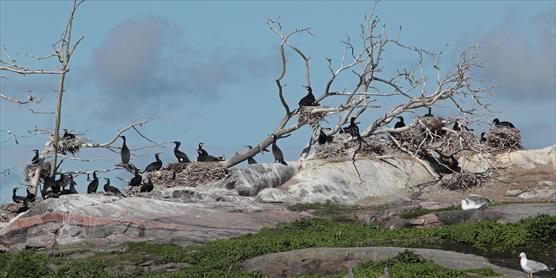Press release 2022-08-03 at 8:00

The vast majority of the Great Cormorant’s breeding population in Finland now lives in large communities of more than 500 pairs. In a large colony, some cormorants can succeed in their nesting despite the predation of White-tailed Eagles. © Heikki Kotiranta
According to a new study, the growing White-tailed Eagle population affects both the location of the Great Cormorant’s nesting colonies and their breeding performance. The White-tailed Eagle plays an increasingly important role in limiting the Great Cormorant population. Finland’s Great Cormorant population has not grown since 2015.
The abundance of the White-tailed Eagle, both in Finland and elsewhere in the Baltic Sea, is one of the great success stories of nature conservation. In addition to the White-tailed Eagle, the Great Cormorant population also increased significantly in Finland from the turn of the millennium. In recent years, the interaction between eagles and cormorants has become more common, and observations of eagles in the vicinity of colonies of Great Cormorants have increased in different parts of the Baltic Sea, especially since the 2010s.
A recent study reveals how the top predator in the food chain, the White-tailed Eagle, affects the nesting of fish-eating Great Cormorants.
The effects of the White-tailed Eagle are manifold
The effects are manifold: the White-tailed Eagle can eat both Great Cormorant eggs and offspring, and also steal fish caught by cormorants. In addition, the eagles scare adult cormorants from their nests, exposing eggs and offspring to predatory gulls and crows.
“The effects of the White-tailed Eagle are already visible in the incubation phase of Great Cormorants. The cormorant colonies of the Gulf of Finland and the Archipelago Sea, where the White-tailed Eagles were seen, had fewer eggs than the colonies where the eagles were not seen,” says Senior Curator Aleksi Lehikoinen from the Finnish Museum of Natural History of the University of Helsinki.
In order to avoid predation of eggs and offspring, Great Cormorants often return to their nests if the White-tailed Eagle stays calm in the colony. However, one colony can be visited by several eagles at the same time, as especially the non-breeding young eagles gather in flocks. Situations have been observed in both Finland and Germany where there are up to 30 White-tailed Eagles in a Great Cormorant colony at the same time.

The photo from the game camera that captured the Great Cormorant colony shows how the White-tailed Sea Eagles are grouped around the flightless chicks. Crows and gulls follow in the wake of the eagles. © BirdLife Finland
The breeding performance of a Great Cormorant colony can remain at zero
“The predation and harassment caused by the White-tailed Eagle can sometimes be so severe that the colony does not produce any offspring in the summer. In just a few years, continuous predation has led to the end of a breeding colony of two thousand nests,” says Researcher Pekka Rusanen from the Finnish Environment Institute.
In a number of European countries, including Finland, Great Cormorant colonies have moved their nesting sites because of the excessive predation of eagles. In Estonia, for example, the number of colonies is highest in the regions with the least White-tailed Eagle nests. In Finland, the Great Cormorant colonies in the outer archipelago have decreased dramatically and the nesting is increasingly concentrated in the inner archipelago.
The White-tailed Eagle’s effect on the Great Cormorant’s breeding population is visible with a delay
Since the 2010s, the majority of the Great Cormorant’s breeding population in Finland has been concentrated in large colonies of more than 500 pairs. In a large colony, some birds can succeed in their nesting despite the predation of eagles. Although the predation of the White-tailed Eagle has continued to increase in recent years, the eagles do not cause losses to colonies in all nesting sites.
The reduced offspring rate of the Great Cormorant affects the size of the breeding population by a delay of two to three years, as fewer Great Cormorants return to their native regions. The Finnish Great Cormorant population has not increased since 2015, and in recent years the population has shown a slight decline.
The study was published in the international Ardea scientific series, whose June issue published a total of 31 articles on Great Cormorants.
Inquiries:
-
Pekka Rusanen, Researcher, Finnish Environment Institute, tel. +358 400 148 691, firstname.lastname@syke.fi
-
Aleksi Lehikoinen, Senior Curator, the Finnish Museum of Natural History, tel. +358 45 1375 732, firstname.lastname@helsinki.fi
-
Eija Järvinen, Communications Specialist, SYKE, firstname.lastname@syke.fi, tel. +358 295 251 242
Link to the original publication: Occurrence and Behaviour of White-Tailed Eagles Haliaeetus albicilla in Great Cormorant Phalacrocorax Carbo Sinensis Colonies in Countries around the Baltic Sea. Ardea, 109(3):565-582 (2022).
Link to the article in HELDA Digital Repositary